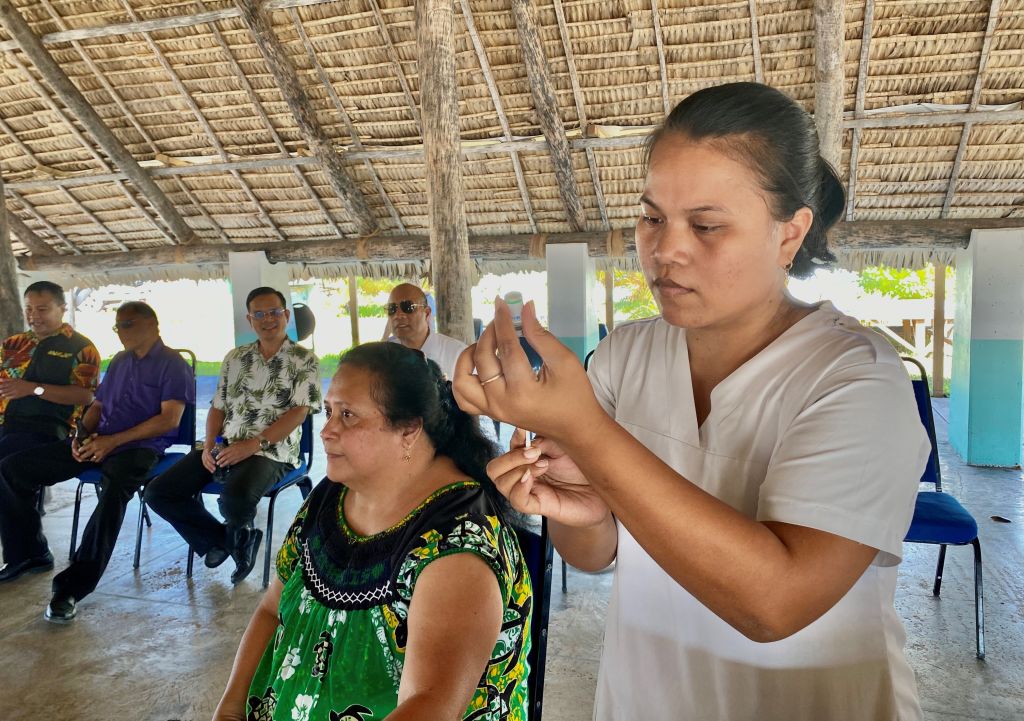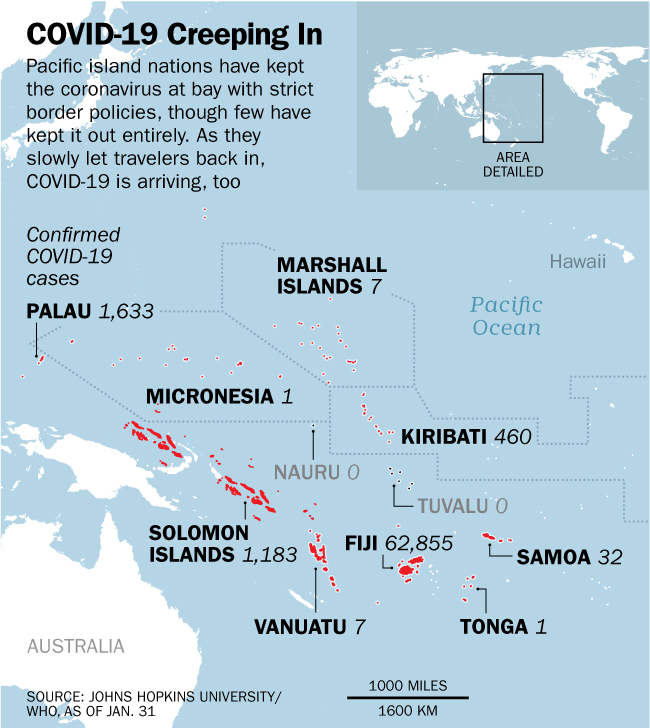
Throughout 2021, hotel workers and others in the tourism industry in the Pacific island nation of Kiribati had rigorous training on how to guard against COVID-19. The two-day course included lessons on proper hand-washing and how to put on and take off personal protective equipment (PPE). It ended with a test—to ensure everyone was proficient.
“It was almost like how you train surgeons when they do operations,” says Petero Manufolau, the CEO of the Tourism Authority of Kiribati.
On Jan. 14, the first passenger plane for 10 months landed in the country, which is located about 2,500 miles southwest of Hawaii. It may also be the last for the foreseeable future. The plane brought the first cases of COVID-19 to the country; more than two-thirds of the passengers tested positive. The flight subsequently set off a wave of COVID-19 cases in the archipelagos, where 120,000 people live across 33 islands with land area smaller than Rhode Island.
At the start of the pandemic, Kiribati slammed its borders closed. The government cracked borders open starting Jan. 10 to allow long-stranded citizens to return home, as well as workers providing technical assistance on the island. Manufolau says that although the government hadn’t announced an official reopening date for tourism, the partial reopening had been seen as a trial run for allowing tourists back in.
“For us it was the beginning of better things to come,” he says. But instead, “the priority for the government is to manage the current situation, so they haven’t gone as far as determining a resumption date for the flights.”
Kiribati’s outbreak after just one flight is emblematic of the struggle for many Pacific nations, which closed off to the world in an effort to protect their minuscule, or even nonexistent, health care resources from COVID-19. As the pandemic enters its third year, they are now weighing how—or even whether—they can restart tourism, which is vital for many Pacific economies.

COVID-19 cases go ‘kaboom’
Thirty-six out of 54 passengers on the flight to Kiribati tested positive on arrival. Six others tested positive in quarantine. That’s despite the travelers spending two weeks in pre-departure quarantine, and only being allowed on the flight after testing negative for COVID-19. The plane was reportedly chartered by the Church of Jesus Christ of Latter-day Saints to bring home missionaries originally from Kiribati who had been stuck overseas.
“Even with the best preparation, it’s not a guarantee that the virus won’t slip through,” says Collin Tukuitonga, the associate dean at the University of Auckland medical school and the former chief executive of New Zealand’s Ministry of Pacific Island Affairs.
More from TIME
The government declared a state of disaster on Jan. 22, ordering a lockdown and curfew. It’s unclear how the virus spread from those on the plane into the community, but on Monday, the government confirmed 96 new positive cases that had been cases transmitted in the community, bringing the total number of cases to 460.
Rimon Rimon, a freelance journalist based in Kiribati’s capital Tarawa, tells TIME that people in the country are concerned “knowing what the virus is capable of,” especially for elderly family members and children who are not yet eligible for vaccines.
He says that many are angry at the government for opening the borders when Fiji, a gateway to the country, is experiencing an outbreak—and before vaccination rates reached higher levels. “I think it’s gotten way out of hand,” he says. “We had two years to prepare for this. People are saying the government is not doing a good job, what has it been doing for the past few years?”
Kiribati has only “a couple” of intensive care beds in the entire country, Dr. Api Talemaitoga, the head of a network of Indigenous Pacific Island physicians, told the Associated Press.
Border controls across the Pacific islands have been effective so far. A handful of these nations have been some of the only places on Earth that went almost untouched by the coronavirus. Tuvalu and Nauru still haven’t recorded a single case of COVID-19, and Micronesia and Tonga have confirmed just one case each, according to the WHO.
The border closures also bought Kiribati and others time to roll out vaccinations. Over 93% of Kiribati’s eligible population has received one COVID-19 vaccine shot, but just over 50% are fully vaccinated.
Elsewhere, Palau has one of the highest vaccination rates in the world, with 99% of the adult population vaccinated. Nauru, Niue, the Cook Islands and Tuvalu have close to 100% of their adult populations fully vaccinated.
Tukuitonga says that in at least some Pacific countries, he expects high vaccination rates to cushion the blow to health systems, but he adds that boosters should be rolled out as soon as possible to contend with the omicron variant.
Despite vaccination rates, several Pacific countries are facing their biggest surges yet as the Omicron variant reaches their isolated shores. “Two or two and a half years later when they try to start joining the world again—kaboom,” says Mia Rimon, of the international development organization Pacific Community.
Samoa—which sits about 800 miles south of Kiribati and which has remained relatively COVID-free over the past two years—reported in January that several returning residents had tested positive for the virus upon touching down. Twenty-two passengers on the flight from Brisbane, Australia tested positive, as have five nurses who looked after them in quarantine. Although the government confirmed that no community transmission occurred, it also suspended repatriation flights.
At least five people died in January in the Solomon Islands—the first COVID-19 deaths in the nation of 687,000. The government blamed the outbreak, the largest of the pandemic, on people who illegally entered the country from Papua New Guinea.
“It is clear that if the numbers continue to rise at the current rate that hospitals and health workers will be completely overwhelmed,” says Tess Newton Cain, the project leader for the Pacific Hub at the Griffith Asia Institute, a research center.
Re-openings delayed
While Kiribati relies on tourism for less than 10% of its GDP, others in the region are much more dependent. Tourism contributes almost 40% to honeymoon dream spot Fiji’s GDP, and more than 40% of the economy in Vanuatu—a renowned destination for divers. That means that many isolated Pacific nations are facing the tough decision of staying shut and protecting their populations, or risk opening up.
Some Pacific nations are keeping borders tightly sealed for now. Tonga turned back a flight from Australia carrying disaster aid following a volcanic eruption due to positive COVID-19 cases on board. Despite the precautions, Tonga detected two cases of COVID-19 this week in port workers where humanitarian aid has been arriving, and local media reported that three more cases had been detected in a family.
A senior official in Vanuatu, which has recorded just 7 cases since the start of the pandemic, said in December that the country’s border could be closed for another year, according to local media.
Fiji reopened to tourism on Dec. 1, 2021, after an outbreak earlier in the year that stretched the health system and a drive to blanket the population with vaccines. Ninety percent of its eligible population is vaccinated. Even then, it hasn’t all gone swimmingly. Some tourists have reported being locked in their hotel rooms without enough support after they tested positive (a claim rejected by Fiji’s tourism authorities).
But the outbreaks gripping places like Kiribati now may mean that some in the Pacific keep their borders sealed for even longer. Says Newton Cain: “All of this will add to already high levels of caution about opening borders in other countries such as Vanuatu and Tonga.”
Manufolau says that Kiribati’s industry is taking the time to get even better prepared for reopening. On Friday, some staff will set sail for remote areas of Kiribati’s Line Islands to deliver the training to operators there. “Instead, of sulking we are taking this as an opportunity to really restart better.”
More Must-Reads From TIME
- The 100 Most Influential People of 2024
- The Revolution of Yulia Navalnaya
- 6 Compliments That Land Every Time
- What's the Deal With the Bitcoin Halving?
- If You're Dating Right Now , You're Brave: Column
- The AI That Could Heal a Divided Internet
- Fallout Is a Brilliant Model for the Future of Video Game Adaptations
- Want Weekly Recs on What to Watch, Read, and More? Sign Up for Worth Your Time
Write to Amy Gunia at amy.gunia@time.com